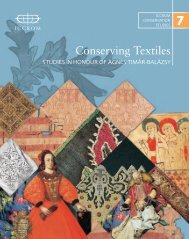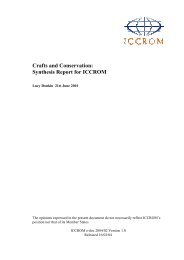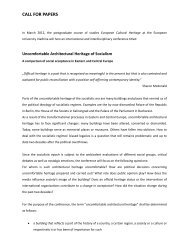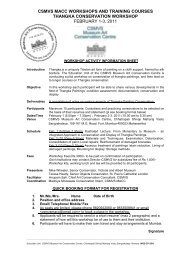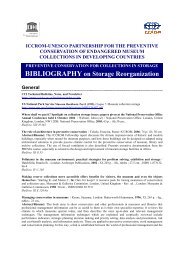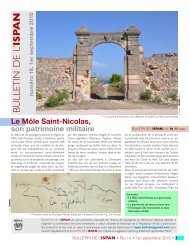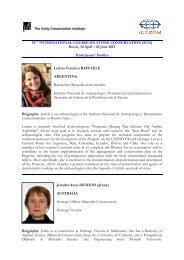part 1 - Iccrom
part 1 - Iccrom
part 1 - Iccrom
Create successful ePaper yourself
Turn your PDF publications into a flip-book with our unique Google optimized e-Paper software.
MEASURING HERITAGE CONSERVATION PERFORMANCE<br />
6th International Seminar on Urban Conservation<br />
the Stone Town adjacent to the former creek, with a<br />
focus on one specific street: Khod Bazaar (a bazaar<br />
street, where from historic times onwards mainly<br />
Indian shops were to be found, Figure 1). The Stone<br />
Town consists of eight wards (mitaa), which each<br />
have their distinctive character.<br />
In the DT, RF and the NF, several attributes that<br />
convey the OUV of the Stone Town can be distinguished.<br />
In these documents 26 attributes are found<br />
both on the urban scale and on level of the individual<br />
building. 5 For the research represented in<br />
this paper, there were two attributes that were highlighted:<br />
the baraza and the carved door. As stated<br />
in the NF: “The Stone Town is an agglomeration of<br />
various architectural traditions from the East African<br />
coast and the world of the Indian Ocean” (URT,<br />
1999, p. 12). Both the barazas and the carved doors<br />
are two attributes in which this cultural fusion can<br />
be seen very explicitly. “[…] the different quarters of<br />
the town were not segregated but bound together by<br />
an intricate network of intimate narrow lanes and a<br />
great series of social nodes, such as mosques, coffee<br />
places and barazas i.e. meeting points that have created<br />
a cosmopolitan whole” (URT, 1999, p. 13). The<br />
barazas can be ascribed to two groups of people in<br />
Zanzibar, Arab and Indian, but each of them gives<br />
form to the barazas in a different way. The carved<br />
doors are an even broader example, for there are<br />
four types of carved doors: 6 Swahili, Arab, Indian<br />
domestic and Indian merchant doors.<br />
Figure 1. The Kiponda mita and the Khod Bazaar (red)<br />
relative to the Stone Town.<br />
These attributes are analysed by dividing them into<br />
these different groups and subsequently authenticity<br />
and integrity will be determined as stated Section<br />
1.<br />
In order to assess the authenticity and integrity of<br />
the carved doors and the barazas, physical research<br />
has been conducted, which resulted in the maps<br />
seen in Figure 2 and Figure 3. Figure 2 indicates the<br />
buildings that contain carved doors. The doors have<br />
been specified to their distinctive origin, being Swahili<br />
(orange brown), Arab (darkish brown), Indian<br />
domestic (brown), Indian merchant (light brown)<br />
and other (beige). The four photographs included<br />
in the figure show the Swahili (left), Arab (middle<br />
left), Indian domestic (middle right) and the Indian<br />
merchant door (right) and clearly depict the distinctive<br />
typology.<br />
Authenticity is about form and design, materials<br />
and substance, use and function, traditions and<br />
location as well as setting, as has been stated in the<br />
Background section, above. Swahili doors are rectangular<br />
and are made up from local timber. The<br />
doors are very simplistic and lack elaborate carvings.<br />
The centre post and/or the lintel are the only<br />
places where one may find carvings, indicating the<br />
status, profession or symbolism associated with the<br />
inhabitant. These doors were the first to be found<br />
in Stone Town and are associated with a domestic<br />
function.<br />
Save the centre post, the respective door does not<br />
clearly suffer from adverse effects of development<br />
and/or neglect. Moreover, all the features that convey<br />
the property’s significance are present. It is<br />
therefore safe to say that the door is intact.<br />
Like the Swahili door, the Arab door is rectangular<br />
and shows right angles in both posts and lintel.<br />
The construction is easily read from the rivets on<br />
the door. The stout rivets — typical of early Arab<br />
doors — are very plain and minimalist, unlike the<br />
extrovert bosses of the Indian domestic doors. The<br />
door is probably made from local wood since the<br />
Indian people imported teak wooden doors, which<br />
endure the Zanzibari climate better. The function<br />
— often elaborately depicted by the carvings on the<br />
door frame — is most likely to be domestic, due to a<br />
lack of a distinct trade made visible in the carvings.<br />
However, the carvings depict the usual carvings of<br />
the Arab doors of Zanzibar; the chain that frames the<br />
door is meant to keep evil spirits out and protect the<br />
inhabitants of the house. Moreover, the chain illustrates<br />
the occupancy of a slave trader. The abstract<br />
image of the fishes at the bottom of the outer post is<br />
Vroomen, Y.; ten Hoope, D.; Moor, B.; Pereira Roders, A.; Veldpaus, L.·& B. Colenbrander. 2012. Assessing the cultural significance<br />
of World Heritage cities: Zanzibar as a case study. In Zancheti, S. M. & K. Similä, eds. Measuring heritage conservation performance, pp.<br />
67-74. Rome, ICCROM.<br />
71



